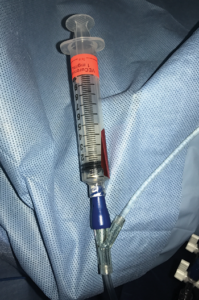
Figure 1: This figure depicts how administration of vecuronium into the medication port of a needleless stopcock can result in the presence of residual agent, which can be accidentally administered in the PACU.
The Institute for Safe Medication Practices (ismp.org) receives reports of medication safety issues from health care providers and regulatory agencies worldwide. Two recent reports from the latter half of 2017 will be discussed here as they are pertinent to anesthesia professional practices.
The first report is a Patient Safety Alert from the National Health Service (NHS) of Great Britain (Alert reference number: NHS/PSA/D/2017/006), which involved a patient in the PACU who accidentally received residual neuromuscular blocker that was left in the intravenous (IV) tubing following a surgical procedure. This action resulted in muscle paralysis, unconsciousness, and respiratory and cardiac arrest (Figures 1 and 2). As a result, providers should be reminded that all intravenous ports and stopcocks should be effectively flushed at the end of the procedure and before transporting the patient to another care ward.1
Another mechanism for the accidental administration of residual agent occurs when two or more IV lines or ports are connected to the same cannula, as flushes may not remove drugs that have back-tracked up one of the lines or accumulated in the additional space within multi-lumen connectors. Use of infusion sets and ports with one-way valves may reduce the risk of backtracking. The NHS recommends the addition of prompts to existing procedure documentation and at patient handover from clinicians in the procedural area, confirming that all cannulae and IV lines that may contain residual drugs have been fully flushed or removed.2

Figure 2: This figure depicts how administration of vecuronium into the needleless medication port of IV tubing can result in the presence of residual agent, which can be accidentally administered in the PACU.
The second report is from the October 5, 2017, ISMP Acute Care Newsletter concerning the alarming rate of continued unsafe injection practices reported by the Centers for Disease Control.3 The survey was completed by 370 physicians with a median of >14 years of clinical experience, whose specialties included anesthesiology-pain management, among others.4 Physicians were asked about the frequency of injection practices by all health care personnel in their work area, along with knowledge and attitudes associated with their own injection practices. The survey suggested that there is a minority (12.4%) of physicians who are still violating basic infection control practices. Survey responses indicated that this same group of physicians (mostly oncologists) reuse a syringe for more than 1 patient, despite findings that most physicians (91.6%) believe that this is an unacceptable practice. Approximately 63% of anesthesia-pain management physician respondents reported reentering multiple-dose vials with a used syringe; while 31.7% of anesthesia-pain management physicians reported the practice of using a single-dose vial for more than 1 patient in their workplace.4
This survey’s results suggest that health care practitioners are still violating best practices associated with safe injections and are placing patients at risk of serious infection. Given these lapses in infection control practices, academic institutions and programs, licensing bodies, and health care providers should enhance their ongoing surveillance of proper technique and devote resources to ensure that trainees and staff have the knowledge and skills associated with even the most basic concepts of infection control and injection safety (CDC guidelines— https://www.cdc.gov/injectionsafety/index.html). Provider campaigns, such as the One & Only Campaign, are available to support safe practices in any setting where injections are delivered, but should not be relied upon alone to promote safe injection practices. The One & Only Campaign (http://www.oneandonlycampaign.org) aims to raise awareness among patients and practitioners about safe injection practices. All anesthesia providers should be familiar with and advocate for these safe injection practices in the workplace.
References
- NHS Improvement Patient Safety Alert: Confirming removal or flushing of lines and cannulae after procedures. Nov. 9, 2017. https://improvement.nhs.uk/uploads/documents/Patient_Safety_Alert_-_Confirming_removal_or_flushing_of_lines_and_cannulae_af_EVC1Yb2.pdf. Last accessed 12/29/2017.
- Albaladejo P, Kinirons B, Brocas E, et al. Recurarization in the recovery room. European Journal of Anesthesiology 1999;16:493–494.
- Alarming survey results from CDC: Unsafe injection practices continue. (2017, October 5). Retrieved from: https://www.ismp.org/newsletters/acutecare/issue.aspx?id=1160
- Kossover-Smith RA, Coutts K, Hatfield KM, et al. One needle, one syringe, only one 1 time? A survey of physician and nurse knowledge, attitudes, and practices around injection safety. Am J Infect Control 2017;45:1018-23.
Dr. Ronald S. Litman, is an anesthesiologist with the Department of Anesthesiology and Critical Care Medicine at The Children’s Hospital of Philadelphia. He presently serves as Medical Director of the Institute for Safe Medication Practices.
He has no conflicts of interest to disclose.


 Issue PDF
Issue PDF